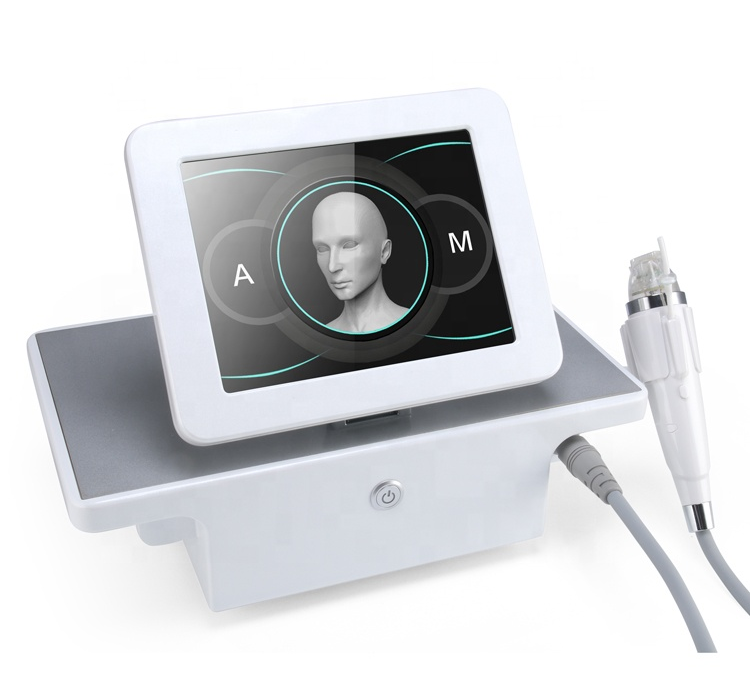Fractional rf microneedle Beauty machine LB185
Microneedle RF Wrinkle Removal Machine LB359
Fractional Radio Frequency Skin Care Beauty Machine LB392
Newest Home Use Fractional RF Skin Tightening Machine LB410
RF Microneedling is a popularly known cosmetic procedure that uses tiny needles to puncture the skin at different depths. This creates tiny holes in the skin that can encourage the formation of collagen.
Microneedling can help with various skin issues, including acne scarring and stretch marks. It can also improve the appearance of wrinkles and fine lines, especially around the eyes and mouth area.
It’s generally safe for all skin types and can be done at home using microneedling rollers or in your dermatologist’s office.
In this article, we will discuss what microneedling is and how it works, what microneedling can treat and what side effects you might experience after the treatment, microneedling price, its benefits, and every other thing you need to know about this cosmetic procedure.
What is microneedling?
Microneedling is also known as collagen induction therapy, as it uses micro-needles to induce collagen production in your skin.
The protein collagen is responsible for the flexibility and strength of your skin. Collagen breakdown is one of the main causes of wrinkles, sagging, and sun damage in our skin. The goal of microneedling is to stimulate collagen production and improve these issues with time.
A microneedling procedure can take anywhere from 15 minutes to several hours and may require more than one session to get desired results.
It’s usually done by a dermatologist or aesthetician, although it can be done at home with the use of an at-home microneedling device.
Microneedling treatment is most often used to improve the appearance of acne scars, stretch marks, and wrinkles. It can also improve skin texture and tone, increase firmness and elasticity, reduce hyperpigmentation (sun damage) and improve overall skin health.
Targeted areas for microneedling treatment
The face is where microneedling is most frequently utilized.
Microneedling is occasionally used to treat stretch marks on other parts of the body in addition to face problems. When mixed with fillers, it can also be used to address stretch marks on the thighs and abdomen.
This cosmetic procedure can also be used to address scarring on other body parts.
Preparing for microneedling
Consider asking the doctor how you can get ready for your appointment before the cosmetic procedure. Ibuprofen and drugs used to treat acne (like Accutane) may need to be stopped well in advance of the surgery.
It’s also advised that you stay away from substances that can make your skin more sensitive. Before your microneedling appointment, your doctor might advise that you stop using retinoids and cleansers for the skin.
Your healthcare professional will look at your skin, go over your medical history, and talk with you about the procedure’s objectives. For you to compare your skin before and after microneedling, they could also take pictures of the area.
Microneedling may be carried out by a dermatologist, plastic surgeon, or aesthetician. Verify that whoever does the procedure has prior expertise in it.
Who is a good candidate for microneedling treatment?
In both medicine and cosmetics, microneedling is used. If you have concerns about any of the following you will be a good candidate for microneedling treatment:
1.Wrinkles or fine lines.
2.Stretch marks
3.Larger pore size.
4.Sagging skin.
5.Mild scars, particularly those caused by burns or acne.
6.A pigmented skin tone.
Additionally, the procedure can benefit those who suffer from illnesses like:
1. Hyperhidrosis (excessive sweating)
2. Alopecia areata (hair loss as a result of autoimmune disease).
Sometimes, medical professionals make use of microneedling to inject medications or vaccines right into your skin.
Who shouldn’t have microneedling?
If you have any of these concerns, consult your doctor before undergoing microneedling treatment.
1.Skin problems like psoriasis or eczema.
2.Skin tags, moles, freckles, and other growths that bleed or fluctuate in size or shape.
3.Keloidal propensity (your skin forms hard, raised scars).
4.Cold sores or frequent skin rashes (contact dermatitis).
5.Receiving chemotherapy or radiation treatment for cancer.
6.Blood conditions or taking anticoagulants (drugs that prevent blood clots).
7.Either has acne or are using acne treatment.
What happens during microneedling?
After cleansing your skin, your healthcare professional adds a numbing cream or ointment, such as lidocaine gel. To give the ointment enough time to function, they perform this between 30 and 45 minutes before the microneedling procedure.
The skin wounds are then created by your healthcare professional using electric equipment or a hand-held roller. Tiny needles are on the roller. Your healthcare professional gently and carefully rolls it over your skin. If they use the electric tool, your skin will be punctured by needles that pulse up and down.
On the electric instrument, they can alter the needle length. Longer needles penetrate the skin more deeply, which may be important if you have deep pockmarks from acne. Between 0.5 millimeters and 2 millimeters are the possible needle lengths.
Once the microneedling begins, you may experience warmth or a stinging sensation on your face. If the needles are placed close to bony parts, like your cheekbones, some people experience pain. There may be some bleeding after deep microneedling.
Depending on the extent of the area that needs to be treated, a microneedling treatment might last anywhere from 15 minutes to several hours.
What happens after microneedling?
Because microneedling is a general cosmetic procedure, you can leave the hospital afterward. For up to five days, your skin could be inflamed and red. A cold compress can ease the irritation. The day following the surgery, the majority of people can wear cosmetics, but you should avoid direct sunlight until your skin has healed.
Microneedling side effects
Microneedling is generally safe for most people when performed by a trained professional.
However, some side effects are possible with this procedure such as:
1.Potential scarring: For persons who have keloids, which are skin scars that resemble huge bubbles, microneedling is not a smart option. It might complicate the issue.
2.Redness and pain: After the procedure, you may experience little pain, and your body might be red for some hours.
3.Bleeding and bruising: Microneedling typically results in no bleeding. However, profound microneedling procedures could result in bleeding or bruised skin.
4.Tearing: While it heals, your skin could feel rough and start to peel.
5.Infection: Small holes made by microneedling in the skin could allow germs to enter, especially if the equipment isn’t thoroughly cleaned. Infection risk is, however, quite minimal. An infection from microneedling is unusual if you’re healthy.
These above side effects usually go away within a few days but if they persist or become worse then contact your doctor immediately. Besides that, the ointment that is used on your skin after a microneedling procedure may cause hypersensitivity. Not keeping your skin properly cleaned, could make the wounds vulnerable to infection. Stay away from visiting rivers or swimming pools since they could be infected with a lot of microorganisms. Avoid using irritant-containing soaps and lotions.
Home rollers, like professional microneedling tools, might spread germs if they aren’t cleaned thoroughly. Avoid using a home roller on inflamed skin.
If you decide to try microneedling at home, proceed cautiously: Don’t use a device with needles longer than 0.25 millimeters (the length of a grain of sand). Shorter needles are safer because they’re less likely to pierce through your skin and cause bleeding or infection.
Cost of microneedling
Microneedling prices vary depending on how many areas are treated, how large each area is treated during each session, your location, the number of sessions you need, and who your provider is.
The average cost for microneedling at a dermatologist’s office ranges from $200 to $700 per session depending on how many sessions it takes to reach your desired results.
As a cosmetic procedure, microneedling is typically not covered by insurance. This implies that all expenses are covered by personal funds. Depending on the clinic, your doctor may accept a payment schedule to help you stretch out the cost.
For a free consultation to go through your desired results and related charges, many providers are available.
Microneedling benefits
RF Microneedling has several benefits, here are some of them:
1.Helps reduce wrinkles, fine lines, and acne scars
2.Reduces pore size.
3.Minimizes dark spots caused by sun damage.
4.Encourages the development of hair in alopecia sufferers.
5.Decreases the apparent presence of hyperpigmentation.
6.Evens out a skin’s varying tone.
7.Enhances skin elasticity.
8.Lessens the visibility of stretch marks.
Conclusion
There are many types of cosmetic procedures that can help improve your looks and self-confidence. One of such procedure is microneedling, which is a safe, effective cosmetic procedure that can be used to treat a variety of skin conditions.
RF Microneedling, which is also referred to as collagen induction therapy is a cosmetic procedure that uses small, sterile needles to create micro-injuries on the surface of the skin, which triggers your body’s usual healing process and promotes the creation of new collagen.
Microneedling can be performed in a doctor’s office or at home with at-home microneedling rollers. Both options are safe for most people, but it’s important to understand the potential risks before undergoing any treatment.
The main advantage of microneedling over other aesthetic procedures is its safety. There’s no risk of infection or other complications like allergic reactions or discoloration of the skin. In addition, microneedling doesn’t require any downtime so it’s ideal if you have an important event coming up soon after treatment.

